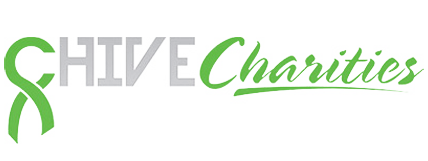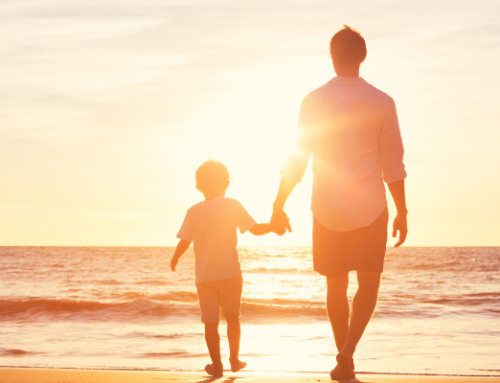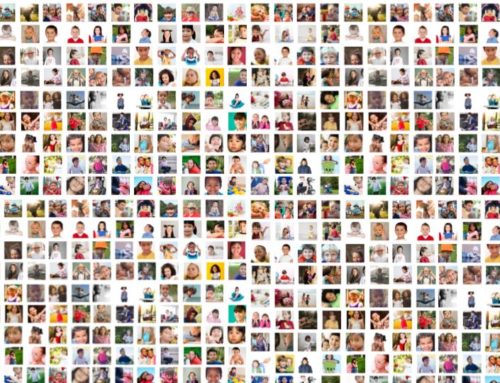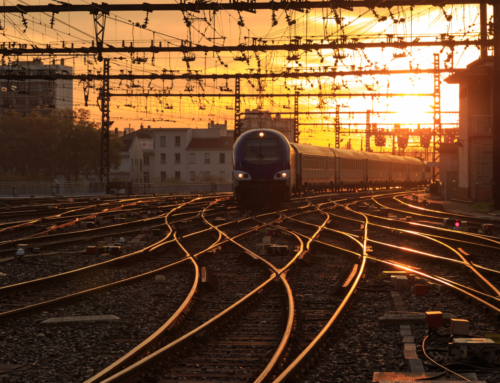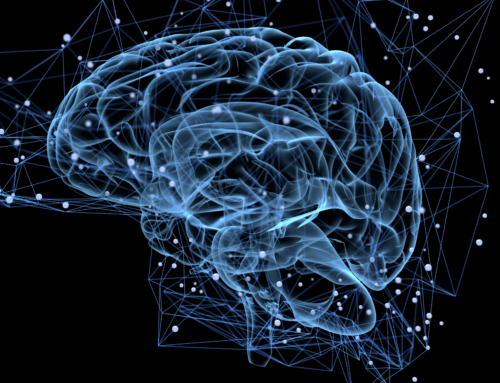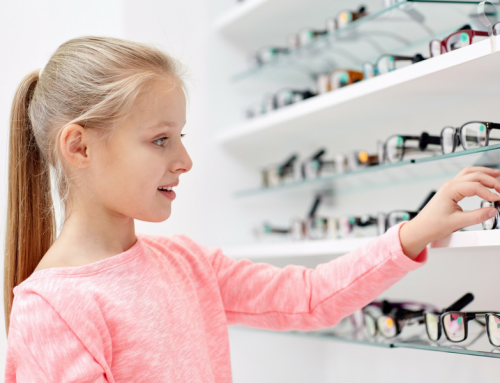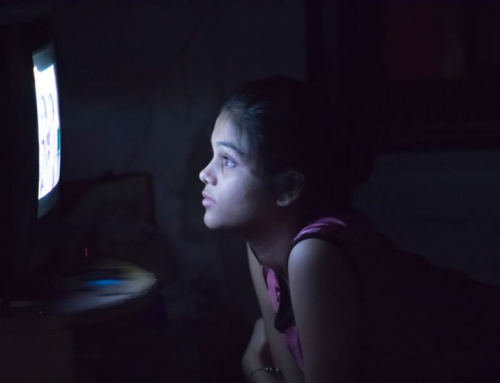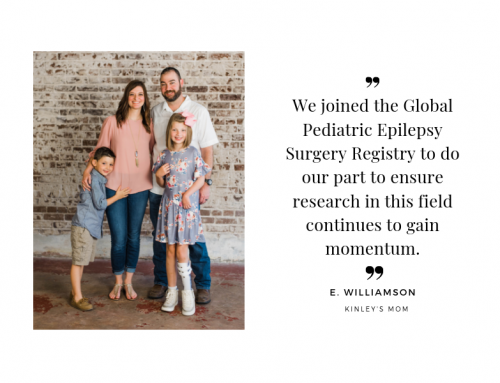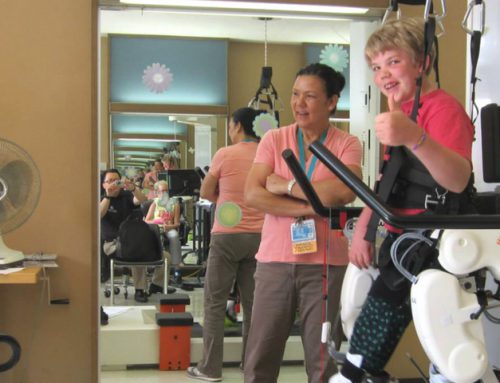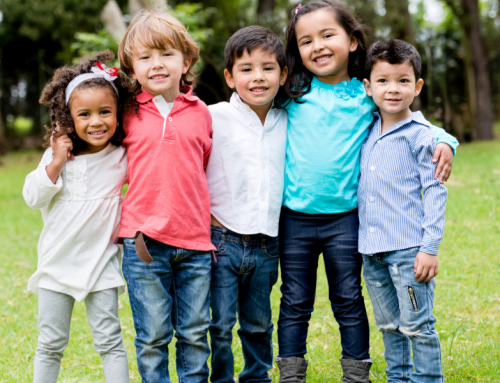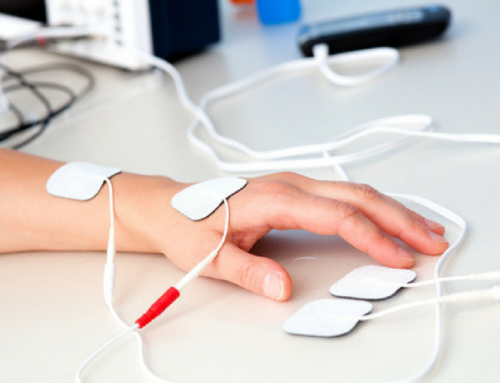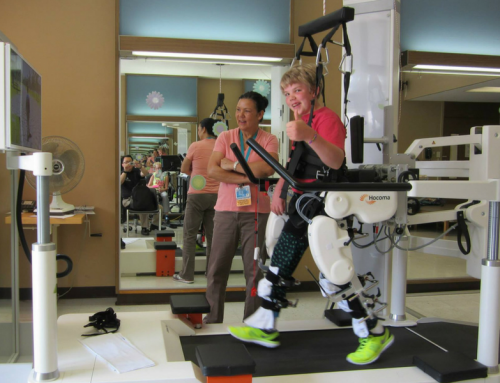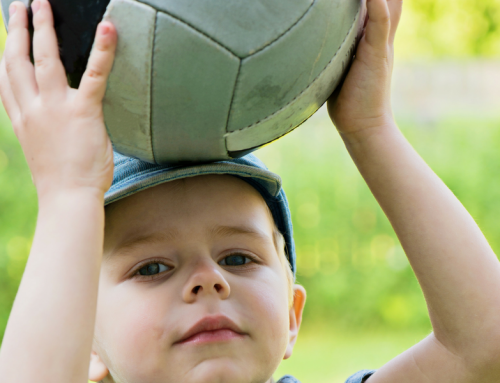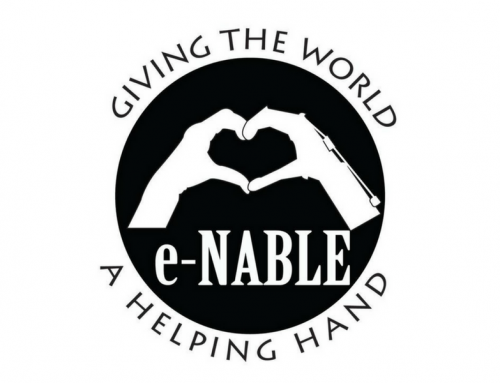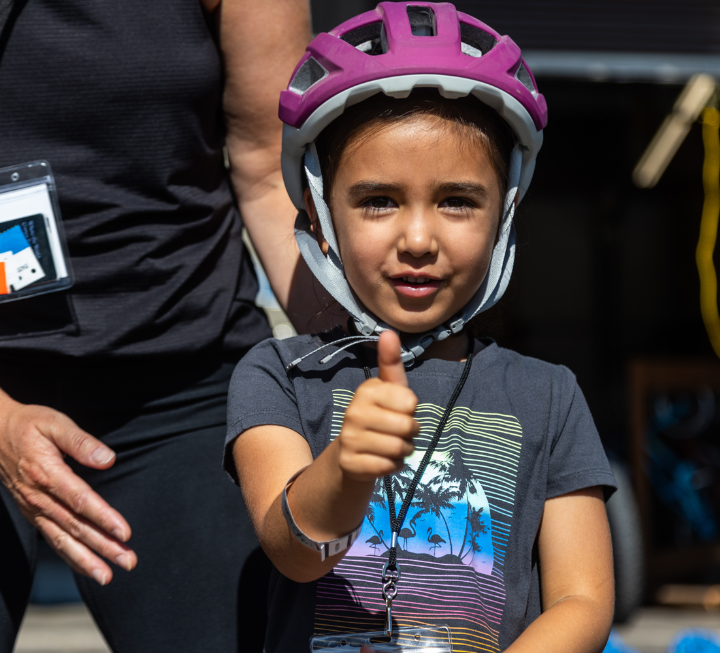This summer, seven children several years post-hemispherectomy participated in the first robotics-assisted physical therapy camp. Fondly known as the Magnificent Seven, these kids received intensive physical therapy specifically targeted at their hand, wrist, and ankle (areas most affected by hemispherectomy surgery) as well as overall locomotion. But fun was in the mix too, in the form of recreational yoga classes and other activities aimed to encourage camaraderie and improve social skills.
This exciting and innovative program initiated by The Brain Recovery Project at the Rancho Los Amigos National Rehabilitation Center in Downey, California, promises to be the platinum standard for 21st century neuro-rehabilitation for children with disabilities. By providing two weeks of intensive, robotics-assisted therapy in a camp-like environment – rather than the sterile setting of a hospital – children participate in a program that targets their specific neurodevelopmental challenges. Grouped with children with similar disabilities, they get to hang out with kids “just like them” in a fun and engaging environment.
Why Rancho?
Rancho Los Amigos National Rehabilitation Center is a leader in neuro-rehabilitation. With their team of highly trained therapists and professionals, and through their research partnerships with the California Institute of Technology (Cal Tech) and the University of Southern California (USC), Rancho is on the leading edge of rehabilitation research. Their research collaborations are helping paralyzed people walk with exoskeletons or control robotic hands with brain computer interfaces.
What’s So Special About Robotics?
Today’s robots sense the patient’s capabilities and provide suitable assistance; in other words, they help the child only as much as they need it by being highly responsive to their movements. Robotics also provide hundreds of repetitions per hour – far more than any human therapist can get out of a child in a typical therapy session. And the best part of robotics is that the child actually wants to engage the robot through the video game interface. This makes therapy fun while at the same time focusing on the specific physical motions that need to be improved.
“Putting blocks in a box over and over and over again just isn’t fun for a child” says Monika Jones, President and co-founder of The Brain Recovery Project. “And these kids are sick and tired of being in a hospital setting. I’ve always thought that there should be a camp where they can receive the very best, most innovative therapy in a fun environment. It’s certainly the least we can do for them after such a drastic procedure. We’re lucky to have Dr. Luis Montes, Director of Pediatrics for Rancho, on our board of directors. He was the one who introduced us to the concept of robotics and to Dr. Mindy Aisen. Dr. Aisen and I had an ‘aha!’ moment at lunch one day when we decided that we would develop a camp for kids post-hemispherectomy on these robots.”
The program was technically a proof-of-concept research study to determine whether intensive therapy could be provided in a camp-like environment. “One thing is certain. This proof of concept ‘experiment’ was a smashing success” says Dr. Mindy Aisen, Chief Medical Officer of Rancho. “The brain is a learning machine throughout life. This is critically important to remember when working with children or adults with any brain disorder. At any time in life there is capacity for plasticity in the human brain to lay down new memories and new motor skills. Just as the elite musician or athlete can hone specific motor skills, the child whom has had a large portion of their brain removed CAN acquire new motor skills by using intensive, engaging, task specific practice. This summer for the first time these children received the most intensive task specific practice possible in a 2 week period: 3 hours per day of exoskeleton assist as needed robotic therapy coupled with video games to keep them immersed and motivated, as well as other generally enriching motor and cognitive programs.”
Did The Children Experience Motor Improvement?
Data collected, including fMRI, is being analyzed now to determine whether the program improved each child’s function. Angie Wathan, whose daughter Josie participated in the program, is certain her daughter’s arm function and gait have improved. “Josie is using her left arm more. She has full range of motion all day long and appears to be moving her left arm more frequently. Before, within two hours, she had limited range of motion and would neglect it. And her gait is better. She has not fallen or tripped since camp. Before, she would trip or fall multiple times a week. Her entire left side is looser. She wants to go back to camp next year and talks about how much fun camp was. The dancing is always the first thing she talks about.”
Dan Huston, whose son Gibson participated in the program, says “we have definitely noticed an improvement in his gait. His local [physical therapist] has also seen an improvement in his gait and hip flexors. This is something they have always worked on during [physical therapy], but Gibson seems to be performing better now.” Sandra Webb, whose daughter Hannah also participated in the program, says “[Hannah] is more aware of and more willing to use her affected side. I think that is due to a combination of using it so much at camp and because when she did use it, she was supported and encouraged by the others regardless of how well it worked. We have carried over Remy’s (the clinical manager) suggestions for shoulder realignment into our [occupational therapy].”
Some children, however, did not have noticeable improvement in gait. “We don’t see any improvement [in gait]” reports Cris Hall, whose daughter Jessie participated in the program. However, “[i]f you look at the camp holistically, it is a great benefit, especially from the social aspect” say Kristi Hall, Jessie’s mom. Jessie says, “I can’t wait to go back!” “Really, the social side was the biggest thing for Jessie. She loved hanging out with all of the other kids.” Dr. Aisen agrees: “[t]he fact that they enjoyed the experience and 100% want to return is a huge success.”
The impact the program had on the therapy team was an unexpected result of this program. “Robocamp was an incredible experience for all of us and it was more successful that I had even hoped” says Dr. Susan Shaw, Assistant Professor of Neurology at USC and epileptologist with Rancho. “I give great kudos to our staff – who, by the way, are some of the best out there – who worked really hard and cared so much about each person. Yet besides staff and equipment, a successful rehabilitation program needs a third ingredient, which is the people doing the therapy. I knew this was going to be a great group of kids, but I didn’t realize just how utterly amazing they would be. They had such great attitudes, determination, and fortitude, and the best smiles you can imagine. It was wonderful to hear them proudly tell me they just beat their high score, to see them concentrating so hard on their robot task that they don’t want to look up at me, and to watch them encouraging each other and becoming great friends. Robocamp 2014 really sets the stage for developing more camps based on this concept, and I am looking forward to it.”
Will The Camp Be Offered Annually?
“The Brain Recovery Project is fully committed to making sure that this program is an annual event. And not just at Rancho, but at other facilities across the country like Research Institute of Chicago in Indianapolis and Blythesdale Children’s Hospital in New York state, where these pediatric robots are now available” says Monika Jones. “Next year we will offer more therapy more specific to each child’s needs and test robot against robot, consider adding neuro-modulation as an arm of the treatment (to assess whether such treatment enhances robotic therapy) and even more rigorously collect and analyze the program” reports Dr. Aisen.
If the decision was left up to Remy Chu, Clinical Manager at Rancho and Adjunct Professor at USC, the answer would be Yes. “Robocamp was such an amazing experience. Getting to know all of the Magnificent Seven and their families was truly an inspiration. The kids’ energy and enthusiasm was contagious and has fueled my drive to combine intensive therapy and technology in helping others regain meaningful outcomes. I am happy to report that preliminary data seem very promising, a confirmation that we are definitely heading in the right direction. Special thanks to the Brain Recovery Project and the Hemispherectomy Foundation for your partnership in this exciting venture.”
Funding
Funding for the camp was was provided by Rancho Research Institute. The Hemispherectomy Foundation provided $3,500 to cover each family’s co-pay, and The Brain Recovery Project initiated the program and covered the expenses for meals, transportation, and other costs. Downey Women’s League donated rooms in their Housing of Medical Emergencies temporary residential facility.
How Can I Help?
At this time, The Brain Recovery Project is actively seeking individual, corporate, or private foundation support for this program. Contact Monika Jones at mjones@brainrecoveryproject.org for more information or donate here now.
Thank you to Chive Charities!
Robocamp 2017 and 2018 is made possible by a very generous $27,000 donation from Chive Charities. We thank Chive Nation for believing in our kids!


